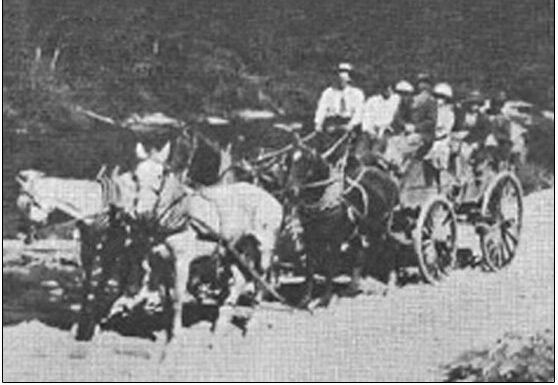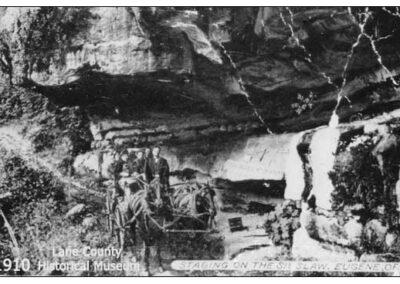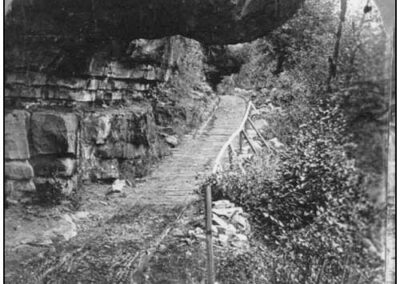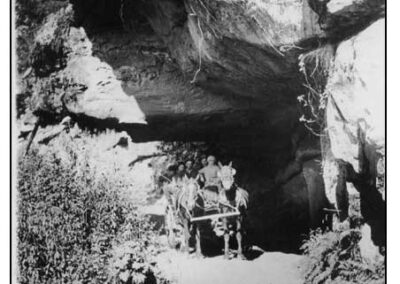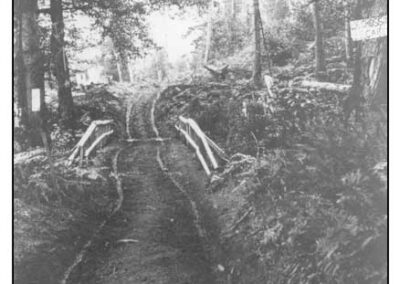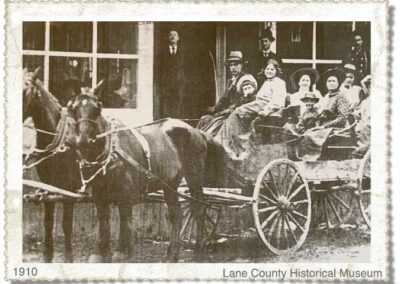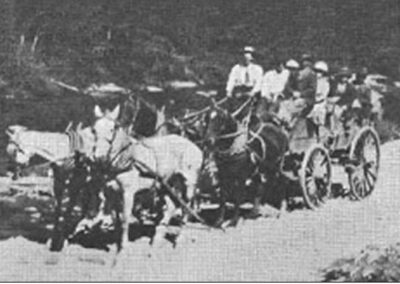During the 1850’s stage service began operating in western Oregon, with weekly service to Eugene. As pioneer settlers and industries grew in the Siuslaw Valley, so did the need and desire for transportation. In time, the stage line from Eugene to Mapleton and lower communities gradually developed.
A four and six-horse stage (“open wagon’) was operated by the Whisman Brothers on Mondays and Thursdays. It ran between the hotel at Top-of-Tide (renamed Mapleton) and Eugene. The hotel was designated as the ‘end of the line’. One stage departed Eugene to Mapleton at 6 a.m., and another departed Mapleton to Eugene at 6 a.m. Mapleton passengers heading to Florence continued on by tug boat on the out-going tide which returned when the tide was full.
Besides passengers, the stage transported freight such as sewing machines, farm equipment and mail. Stage drivers were met with numerous challenges along the winding trails – stage break downs, mud, trail debris, etc. When conditions proved too difficult to traverse, one driver would continue on horseback, to ensure the mail reached its destination. In time, the route was improved when a road was established through Badger Mountain, down Wildcat Creek, to the Siuslaw and Swisshome areas. Stage stations were built every 20 or 30 miles to change horses and accommodate passengers either with a meal or overnight accommodations. The stop-over was often run by pioneer families providing a bunk and perhaps a wash basin. Stage drivers usually earned $35 to $50 per month, plus room and board.
Earl McNutt, a former stage driver on the Eugene-Mapleton route, once reflected on his many years as a driver. He described the schedule had two seasons. During the summer, a four-horse stage team departed Eugene, with an overnight stop at Elk Prairie (the Hale Farm, west of Noti). Then using fresh horses, two other drivers would take passengers on to Mapleton. The duration of the Eugene to Mapleton trip? About 14 hours.
The winter months required a two-horse stage, often with another driver added between Elmira and Hale. If weather conditions called for it, an additional driver would take over the final leg between Hale and Mapleton. As such, duration of the winter trip varied between 18 to 24 hours.
Over the Bank
In 1907 a stage on the Barnard and West’s Eugene-Mapleton line encountered trouble at Tilden Rock (10 miles from Mapleton) during the late evening hours. It occurred where water from the mountain often cascaded onto the trail causing a treacherous path. On a wet January day, the horses slipped on the muddy surface and were unable to get up on their own. The drivers unhitched the team as the horses struggled unsuccessfully to regain their footing. The path proved too slippery and both horses fell 30 or 40 feet down the bank into the river. One horse was killed instantly. The other horse could not be seen, but was assumed to have also been killed. However in the morning, the second horse was seen across the river, standing on all fours. It seems the horse had fallen into the river and was lucky enough to swim across to the other side. Luck was also with the stage driver Frank Taylor that night. His foot had become entangled with the horses’ harness and he too nearly went over the bank before freeing himself.
Mapleton to Indian Creek Stage
In 1907 Ray Walker was a stage driver transporting passengers, freight, and mail between Mapleton and up Indian Creek. He would complete the trip to Mapleton in one day, stay the night then do the return trip the next day. During the winter, this route required two men and four horses for the stage to get through. The passenger fare was $5. Mr. Walker was paid $40 per month, including room and board.
A future story will feature early postal service in the Sisulaw Valley.
_____________
Sources:
Lane County Historian. Lane County Historical Society. Vol. XVI, No. 2; Summer, 1971. Pg. 28
McNutt, Earl L.; Siuslaw Pioneer; Staging Between Eugene and Mapleton. 1951, pg 35
Register Guard. ”Looking Back” 3 Sept 1990.
Siuslaw Pioneer; Stage Team Falls Over Bank. 1956 VOL IX; PG 35
Whisman, Frank, “The Whisman Brothers”. The Siuslaw Pioneer, 1956 pg 23-24
IMAGES:
Lane County History Museum Images
-Mapleton Region, 1910 Catalog number GN3639
-Mapleton Region, 1913 Catalog number GN4501
-Stage Bridge, 1909 Catalog number GN4503

